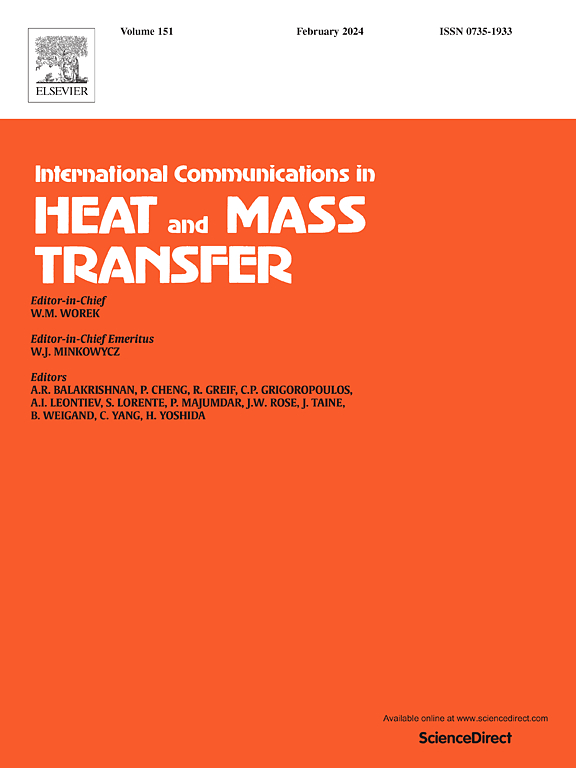Bicriteria optimization of subcooled flow boiling in graphene-coated microchannels using response surface methodology
IF 6.4
2区 工程技术
Q1 MECHANICS
International Communications in Heat and Mass Transfer
Pub Date : 2025-03-27
DOI:10.1016/j.icheatmasstransfer.2025.108914
引用次数: 0
Abstract
This study investigates the optimization of subcooled flow boiling in microchannels coated with graphene nanoplatelet (GNP) surfaces of varying wettability and roughness using response surface methodology (RSM). Four surface treatments: uncoated, SHi-GNP (superhydrophilic), SHo-GNP (superhydrophobic), and U-GNP (dual-wettability), are compared to assess the influence on key performance parameters, including Nusselt number (Nu) and pressure drop (Δp). Experimental results show that SHi-GNP achieves the best balance between high heat transfer performance (Numax = 82.9) and low pressure drop (Δpmin = 441.4 Pa), attributed to its enhanced wetting properties that promote effective rewetting and bubble nucleation. U-GNP exhibits the highest Nusselt number (Numax = 108.9), but at the cost of the highest pressure drop (Δpmin = 2017 Pa), due to its combined hydrophilic and hydrophobic regions that enhance nucleation but increase fluid resistance due to high surface roughness. SHo-GNP manifests moderate improvement in both heat transfer and pressure drop, while the uncoated surface shows the lowest performance. RSM proves effective in identifying optimal Reynolds numbers and power inputs for each surface treatment, facilitating bicriteria optimization of heat transfer and fluid flow performance. These findings provide valuable insights into the design of microchannel heat sinks for high-performance electronics cooling.
求助全文
约1分钟内获得全文
求助全文
来源期刊
CiteScore
11.00
自引率
10.00%
发文量
648
审稿时长
32 days
期刊介绍:
International Communications in Heat and Mass Transfer serves as a world forum for the rapid dissemination of new ideas, new measurement techniques, preliminary findings of ongoing investigations, discussions, and criticisms in the field of heat and mass transfer. Two types of manuscript will be considered for publication: communications (short reports of new work or discussions of work which has already been published) and summaries (abstracts of reports, theses or manuscripts which are too long for publication in full). Together with its companion publication, International Journal of Heat and Mass Transfer, with which it shares the same Board of Editors, this journal is read by research workers and engineers throughout the world.

 求助内容:
求助内容: 应助结果提醒方式:
应助结果提醒方式:


